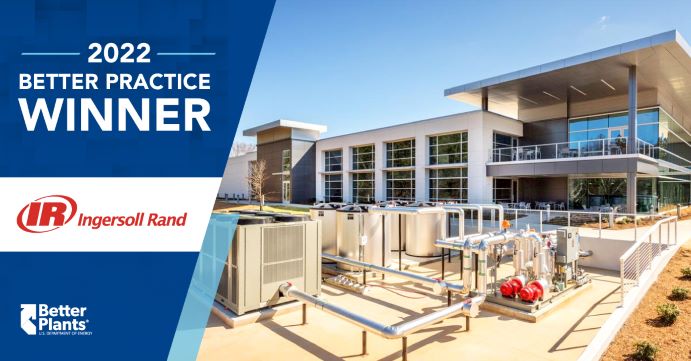Ingersoll Rand was recently recognized by the U.S. Department of Energy (DOE) with a 2022 Better Practice Award for its innovative and industry-leading accomplishments in implementing and promoting practices, principles and procedures of energy management.

As a member of DOE’s Better Building Initiative and Better Plants partner, Ingersoll Rand works with the DOE and other leading manufactures to boost their competitiveness through improvements in energy efficiency.
“Better Plants partners are combating the climate crisis through meaningful energy, water, and waste reduction efforts. The Better Plants Better Practice and Better Project awards highlight innovation in industrial sustainability and a willingness to share good ideas,” said Carolyn Snyder, Deputy Assistant Secretary for Energy Efficiency at the U.S. Department of Energy.
Ingersoll Rand was formally recognized at the 2022 Better Buildings, Better Plants Summit on May 18, 2022. As part of the broader Better Buildings Initiative, Better Plants partners voluntarily set a long-term goal, typically to reduce energy intensity by 25 percent over a 10-year period across all their U.S. operations. DOE supports these efforts with technical expertise and national recognition.
Keeping to Cool in West Chester, PA
Ingersoll Rand was specifically recognized for addressing fugitive emissions at its facility in West Chester, Pennsylvania. By replacing CFX heat exchangers with more efficient LCX units, they reduced 1,340 annual metric tons of CO2 in the first year of implementation. New leak detection processes and testing practices would also be implemented to support the West Chester team’s goal of decreasing CO2 emissions by approximately 98%.
The project will span over five years with 1,600 dryers being converted to more eco-friendly models. The investment to replace our CFX heat exchangers with the more efficient LCX units will decrease GHG emissions 98% by the end of Q1 2025. Early calculations estimate that over 1,340 metric tons of CO2 will be eliminated in 2021. Once the five-year project is complete, over 69,578 metric tons of CO2 are expected to be saved.